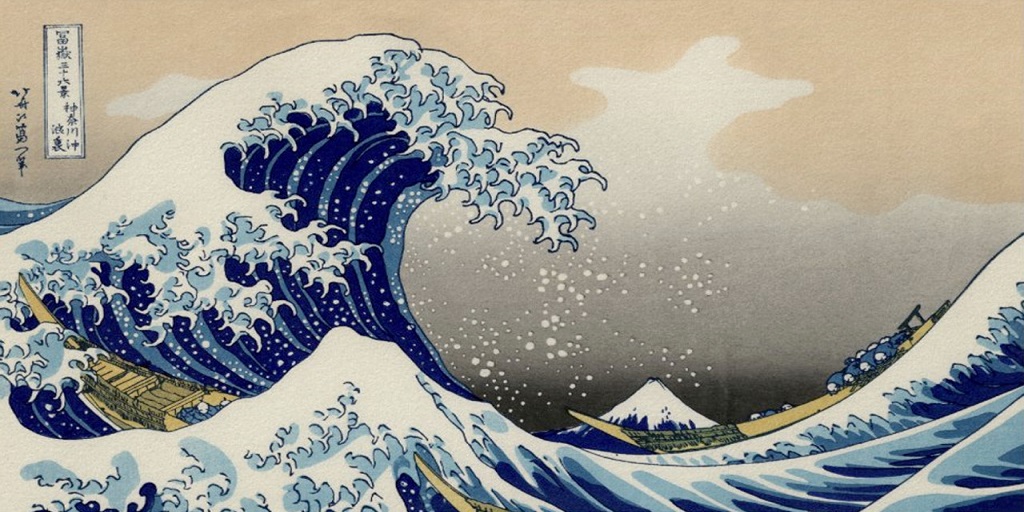
You have likely seen this masterpiece before, though you may not know the artist. But you remember the emotion and the feeling the work gave you, no matter where you saw it.
Katsushika Hokusai’s The Great Wave off Kanagawa continues to captivate audiences worldwide, resonating across centuries, cultures, and artistic disciplines. Its dynamic depiction of a powerful wave, poised to crash over helpless fishermen, offers a profound meditation on the relationship between humanity and nature.
Yet, the appeal of this iconic image lies not only in its visual drama but also in its historical, artistic, and symbolic layers.
Humanity vs. Nature
At its core, The Great Wave tells a gripping story of human vulnerability against nature’s might. The fishermen beneath the wave symbolize the universal struggle for survival, a theme that resonates with anyone facing overwhelming challenges.
Unlike images that celebrate humanity’s triumph over nature, this composition underscores nature’s dominance. The wave is a force of awe and terror, with its claw-like arcs encapsulating a moment of imminent peril. This emotional tension makes the image not only visually arresting but also thematically timeless.
Hokusai’s Printing Methods
The wave’s visual elements are equally compelling. Hokusai’s mastery of ukiyo-e woodblock printing shines through in the crisp lines, bold colors, and intricate details. The use of Prussian blue, a novel pigment at the time, gives the wave its striking vibrancy and contributes to its enduring appeal.
The interplay of traditional Japanese aesthetics and Western influences, such as linear perspective and a low horizon line, creates a composition that feels both familiar and novel. This blending of styles reflects the cultural crosscurrents of the Edo period, capturing a moment when Japan’s isolation was beginning to erode.
A Part of A Greater Work?
Another layer of intrigue lies in its context as part of the series Thirty-Six Views of Mount Fuji. While the wave dominates the foreground, Mount Fuji, a symbol of stability and spirituality, anchors the composition in the distance. This juxtaposition of chaos and calm mirrors the duality of life itself, offering a deeper philosophical reflection.
The cultural journey of The Great Wave further amplifies its significance. Initially a popular print sold to Edo-period tourists, it transcended its origins to become a global phenomenon. Its introduction to Europe during the Japonisme craze of the late 19th century influenced artists like Claude Monet and Edgar Degas, who admired its flattening of space and vivid colors.
Claude Debussy’s La Mer drew inspiration from the print, and its reach has extended into modern times, appearing on everything from book covers to emojis. These days, people who love Japanese art often get The Great Wave poster as part of their home decor, as it is so iconic.
The Appeal and Value of the Wave
The wave’s symbolism has evolved alongside its widespread recognition. It is often evoked during times of natural disaster, such as the 2011 earthquake and tsunami in Japan, as a representation of nature’s overwhelming power.
Yet, it also serves more playful purposes, as the Great Wave poster is found in homes, or adorning tattoos, fashion, and advertisements. This versatility underscores its adaptability as a cultural icon, capable of conveying both profound and lighthearted meanings.
Ultimately, The Great Wave endures because it speaks to universal themes of power, resilience, and awe. Its ability to encapsulate an entire narrative in a single image, while inviting endless interpretations, ensures its relevance in a constantly changing world.
Hokusai’s masterpiece will continue to inspire and enthrall, proving that its waves will ripple through time indefinitely. If you want to bring the essence of Hokusai’s work into your home we recommend visiting the Museum of Fine Arts, Boston, where you can find Great Wave posters and other Hokusai gifts that pay homage to the artist’s work.


